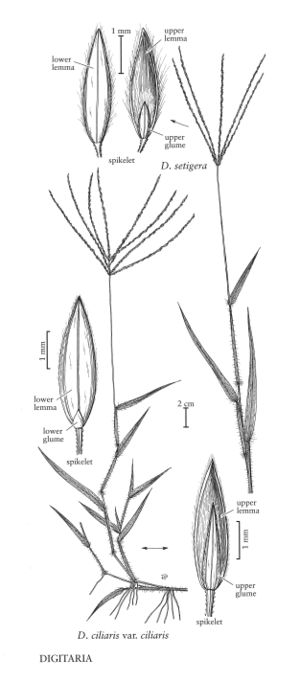Difference between revisions of "Digitaria setigera"
FNA>Volume Importer |
imported>Volume Importer |
||
| (4 intermediate revisions by 2 users not shown) | |||
| Line 3: | Line 3: | ||
|accepted_authority=Roth | |accepted_authority=Roth | ||
|publications= | |publications= | ||
| + | |special_status={{Treatment/ID/Special_status | ||
| + | |code=I | ||
| + | |label=Introduced | ||
| + | }} | ||
|basionyms= | |basionyms= | ||
|synonyms= | |synonyms= | ||
| Line 16: | Line 20: | ||
-->{{Treatment/Body | -->{{Treatment/Body | ||
|distribution=Puerto Rico;Pacific Islands (Hawaii);Fla. | |distribution=Puerto Rico;Pacific Islands (Hawaii);Fla. | ||
| − | |discussion=<p>Digitaria setigera is native to southeastern Asia. It is now established in tropical America, growing in disturbed habitats in Florida and Central America, and probably in tropical South America. It has often been confused with D. sanguinalis.</p><!-- | + | |discussion=<p><i>Digitaria setigera</i> is native to southeastern Asia. It is now established in tropical America, growing in disturbed habitats in Florida and Central America, and probably in tropical South America. It has often been confused with <i>D. sanguinalis</i>.</p><!-- |
| − | --><p>Plants in the Flora region belong to Digitaria setigera Roth var. setigera. Unlike plants of D. setigera var. calliblepharata (Henrard) Veldkamp, they do not have large, glassy hairs on their lower lemmas.</p> | + | --><p>Plants in the Flora region belong to <i>Digitaria setigera</i> Roth var. setigera. Unlike plants of <i>D. setigera</i> var. calliblepharata (Henrard) Veldkamp, they do not have large, glassy hairs on their lower lemmas.</p> |
|tables= | |tables= | ||
|references= | |references= | ||
| Line 26: | Line 30: | ||
-->{{#Taxon: | -->{{#Taxon: | ||
name=Digitaria setigera | name=Digitaria setigera | ||
| − | |||
|authority=Roth | |authority=Roth | ||
|rank=species | |rank=species | ||
| Line 33: | Line 36: | ||
|basionyms= | |basionyms= | ||
|family=Poaceae | |family=Poaceae | ||
| − | |illustrator=Linda A. Vorobik | + | |illustrator=Linda A. Vorobik;Hana Pazdírková |
| + | |illustration copyright=Utah State University | ||
|distribution=Puerto Rico;Pacific Islands (Hawaii);Fla. | |distribution=Puerto Rico;Pacific Islands (Hawaii);Fla. | ||
|reference=None | |reference=None | ||
|publication title= | |publication title= | ||
|publication year= | |publication year= | ||
| − | |special status= | + | |special status=Introduced |
| − | |source xml=https:// | + | |source xml=https://bitbucket.org/aafc-mbb/fna-data-curation/src/200273ad09963decb8fc72550212de541d86569d/coarse_grained_fna_xml/V25/V25_1089.xml |
|subfamily=Poaceae subfam. Panicoideae | |subfamily=Poaceae subfam. Panicoideae | ||
|tribe=Poaceae tribe Paniceae | |tribe=Poaceae tribe Paniceae | ||
Latest revision as of 18:55, 11 May 2021
Plants of indefinite duration. Culms to 120 cm tall, bases long-decumbent and rooting at the lower nodes. Sheaths with papillose-based hairs; ligules 2.5-3.5 mm; blades 4-28 cm long, 4-12 mm wide, scabrous, usually with some scattered papillose-based hairs on the base of the adaxial surfaces, sometimes with hairs all over. Panicles with 3-11 spikelike primary branches in 1-several whorls, rachises to 6 cm; primary branches 5-15 cm, axes wing-margined, wings more than 1/2 as wide as the midribs, lower and middle portions bearing spikelets in unequally pedicellate pairs; secondary branches absent; shorter pedicels 0.3-0.8 mm; longer pedicels 1.7-2.7 mm. Spikelets 2.4-3.5 mm, homomorphic, ovate. Lower glumes absent or to 0.1 mm; upper glumes 0.2-1.3 mm, 1/6 - 1/3 as long as the spikelets, 1-3-veined, margins and apices with appressed, white hairs about 0.5 mm, truncate or bilobed; lower lemmas (5)7-veined, veins smooth or scabrous only over the distal 1/3, unequally spaced, margins and lateral intercostal regions silky-ciliate; upper lemmas tan or gray when immature, brown at maturity, acuminate; anthers 0.6-1.3 mm. 2n = 70, 72.
Distribution
Puerto Rico, Pacific Islands (Hawaii), Fla.
Discussion
Digitaria setigera is native to southeastern Asia. It is now established in tropical America, growing in disturbed habitats in Florida and Central America, and probably in tropical South America. It has often been confused with D. sanguinalis.
Plants in the Flora region belong to Digitaria setigera Roth var. setigera. Unlike plants of D. setigera var. calliblepharata (Henrard) Veldkamp, they do not have large, glassy hairs on their lower lemmas.
Selected References
None.
